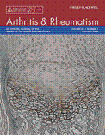Differential expression of αB-crystallin and evidence of its role as a mediator of matrix gene expression in osteoarthritis
Abstract
Objective
Alpha B–crystallin belongs to the family of small heat-shock proteins (HSPs). The role of this protein family in chondrocytes is not well understood. The present study was undertaken to investigate expression levels of αB-crystallin in chondrocytes isolated from healthy subjects and patients with osteoarthritis (OA), and to explore the functional role of this potentially interesting protein in chondrocyte metabolism.
Methods
Western blot and real-time reverse transcriptase–polymerase chain reaction (RT-PCR) analyses were performed to determine expression levels of αB-crystallin in healthy and OA chondrocytes cultured in alginate beads. RNA interference–mediated gene knockdown was used to explore the role of this small HSP in chondrocyte biology, by transfecting low concentrations of small interfering RNA (siRNA) in cultured chondrocytes.
Results
We initially identified αB-crystallin as a small HSP that was differentially expressed between healthy and OA-affected chondrocytes. The decreased abundance of this protein in OA chondrocytes was confirmed by Western blotting. Moreover, real-time RT-PCR confirmed the differential expression between chondrocytes isolated from visibly intact and visibly damaged zones of OA cartilage. The proinflammatory cytokines interleukin-1β and tumor necrosis factor α both down-regulated αB-crystallin expression. Transfection of low concentrations of siRNA in cultured chondrocytes resulted in efficient knockdown of αB-crystallin gene expression. This was accompanied by altered expression of the chondrocyte-specific bone morphogenetic protein 2, aggrecan, and type II collagen genes.
Conclusion
The present findings identify the small HSP αB-crystallin as a novel mediator of chondrocyte matrix gene expression that may contribute to altered chondrocyte metabolism during the development of OA.




